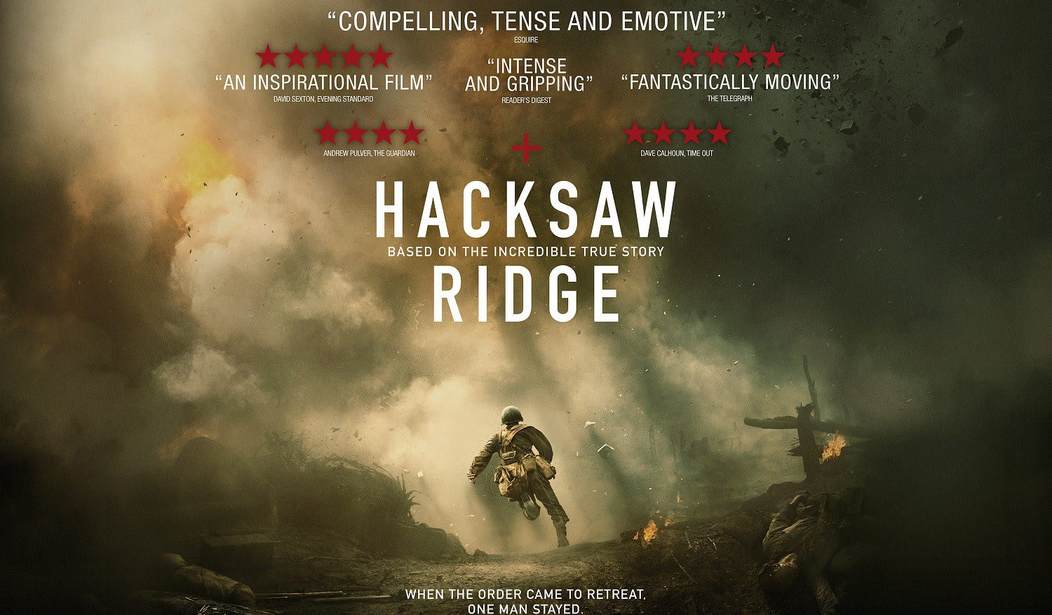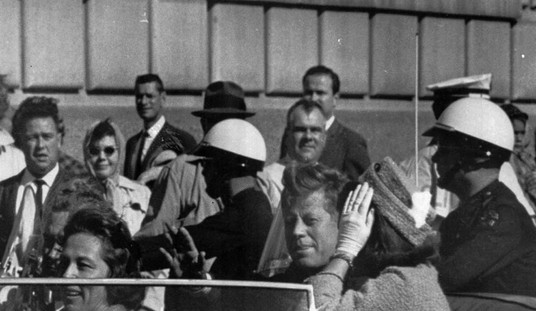For the first hour or so of Hacksaw Ridge, we’re on familiar cinematic turf: young Desmond Doss, a backwoods, religious country boy cut from the same cloth as Sgt. York., endures the alcoholic abuse of his shell-shocked World War I-veteran father and the rivalry of his brother as he shyly courts a pretty nurse. A Seventh-Day-Adventist, Desmond takes literally the Bible’s commandment, Thou Shalt Not Kill, especially when he nearly kills his brother during a father-sanctioned bout of fisticuffs — but when the time comes for him to enlist, he doesn’t hesitate.
Bullied by a drill sergeant straight out of Kubrick’s Full Metal Jacket, despised and harassed by his fellow recruits, Doss endures the hazing and even a court martial in pursuit of his objective: to save lives without taking one. All he asks is that he never has to pick up a rifle. And he never does, even while winning the Medal of Honor for rescuing 75 wounded American soldiers as a medic during perhaps the bloodiest battle of the Pacific campaign — the life and (mostly) death struggle for Okinawa, the stepping-stone to the Japanese home islands.
And that’s the second hour, which is where this movie really lives.
Violence in cinema has been on an ever-increasing arc since Arthur Penn’s Bonnie and Clyde, whose bullet-riddled finale shocked audiences back in 1967. Sam Peckinpah took the ballet of blood to the next level in his masterpiece, The Wild Bunch (1969), a movie whose entire third act consists of a violent shoot-out in a small Mexican village. Horror schlockmeisters and lesser talents have been exploiting the special-effects department ever since. But it was not until Steven Spielberg’s Saving Private Ryan (1998) that realistic gore was turned to the service of war; the first 20 minutes of that film are among the most intense in movie history.
And now, in Hacksaw Ridge, the director of Braveheart and The Passion of the Christ — two films that unsparingly presented the brutal ethos of their eras — has put his considerable talents in the harnessing of industrial-strength belligerence to this tale of unsuspected heroism: a triumph of one man over the machinery of death, alone, defenseless and armed only with determination, faith, courage and the will not only to live, but save.
This is familiar territory for Gibson, whose work as both an actor and director is suffused with the redemptive, transformative power of pain. Jesus is nearly scourged to death, then nailed to a cross to die; in extremis, he cries out to God, “Why have you forsaken me?” accepts his fate, and dies. (Gibson is now working on a companion film about the Resurrection.) The Scottish hero, William Wallace, is drawn and quartered by the English, completing his transformation from outlaw and rebel into national hero. Even Martin Riggs, the suicidal, borderline crazy hero of the Lethal Weapon series, undergoes various agonies, as in his climatic battle with the bad guy (played chillingly by Gary Busey) in the first and best movie of the cycle:
But while Doss — played with disarming simplicity by the American-born British actor Andrew Garfield (the rest of the cast is largely Australian) — wades through hellfire armed only with his faith, Hacksaw Ridge is not primarily about faith. It’s about the private courage and determination of every soldier in the field, whether American or Japanese, fighting for a cause he believes in, and leaving the details to chance, or God, or the odds. In the steel rain of Okinawa, where Japanese warriors emerged from hidden tunnels, where booby traps lay under every unsuspecting foot, determining who lived or died was something beyond even a general’s pay grade; you just did your duty until either the fighting stopped, or you were dead, or both.
The graphic, realistic violence is not so much wallowed in (as Gibson’s detractors will charge) as dispassionately observed. Good men die; bad men live; survival is not a matter of moral superiority but simply dumb luck — in a scene that echoes the one in Saving Private Ryan, a soldier first survives a shot to the helmet, marvels at his luck, and then takes one in the brain. Legs get blown off, torsos sundered. The Japanese commander, when it’s clear the battle has been lost to the Americans, commits ritual seppuku, disemboweling himself as he is beheaded by a subaltern. Meanwhile, Doss staggers through the carnage, repeatedly imploring God, “Please let me save just one more,” hoisting another damaged body, and rappelling the men down a sheer cliff face via a harness and a rope ladder.
We write and film the stories of the survivors; Hacksaw Ridge has its origins in part in The Conscientious Objector, a documentary made about Doss, who died in 2006 (you can watch it at the link). As any combat veteran will tell you, men of equal or greater valor perished on the killing fields, most of their stories lost to history. In his focused reliance on his faith, Doss may well have been shielded from serious harm by the hand of God. He certainly thought so. We’ll not know until if and when we get to heaven.
In the meantime, here on earth, there is only the fighting. Not since Pork Chop Hill (1959), one of the rare movies about the Korean War, has a war film been this focused on combat at the expense of its personal subplots (Doss’s brother vanishes from the film once Desmond goes to war, for example, and we don’t see nearly enough of the coquettish Teresa Palmer, who plays Doss’s wife Dorothy, once the thunder starts). But war is what Gibson’s movie is about — not just what it does to one man, but all men.
And this, I think, is the real genius of the picture. Doss is not Gregory Peck, John Wayne or Superman, but Everyman, wondering how he’ll behave when the first shots are fired, the first bodies wounded, the first men die. Controlling his fear, leaving his fate in the hands of a higher power while all the powers of Hell are ranged against him. Head down, eyes peeled, triangulating as he goes, praying to find just one more before his task is ended. (Doss even save a few Japanese soldiers, who were summarily dispatched at the bottom.)
His Medal of Honor citation reads:
Private First Class Desmond T. Doss, United States Army, Medical Detachment, 307th Infantry Regiment, 77th Infantry Division. Near Urasoe-Mura, Okinawa, Ryukyu Islands, 29 April – 21 May 1945. He was a company aid man when the 1st Battalion assaulted a jagged escarpment 400 feet high. As our troops gained the summit, a heavy concentration of artillery, mortar and machinegun fire crashed into them, inflicting approximately 75 casualties and driving the others back. Private First Class Doss refused to seek cover and remained in the fire-swept area with the many stricken, carrying them one by one to the edge of the escarpment and there lowering them on a rope-supported litter down the face of a cliff to friendly hands. On 2 May, he exposed himself to heavy rifle and mortar fire in rescuing a wounded man 200 yards forward of the lines on the same escarpment; and two days later he treated four men who had been cut down while assaulting a strongly defended cave, advancing through a shower of grenades to within eight yards of enemy forces in a cave’s mouth, where he dressed his comrades’ wounds before making four separate trips under fire to evacuate them to safety. On 5 May, he unhesitatingly braved enemy shelling and small-arms fire to assist an artillery officer. He applied bandages, moved his patient to a spot that offered protection from small-arms fire and, while artillery and mortar shells fell close by, painstakingly administered plasma. Later that day, when an American was severely wounded by fire from a cave, Private First Class Doss crawled to him where he had fallen 25 feet from the enemy position, rendered aid, and carried him 100 yards to safety while continually exposed to enemy fire.
On 21 May, in a night attack on high ground near Shuri, he remained in exposed territory while the rest of his company took cover, fearlessly risking the chance that he would be mistaken for an infiltrating Japanese and giving aid to the injured until he was himself seriously wounded in the legs by the explosion of a grenade. Rather than call another aid man from cover, he cared for his own injuries and waited five hours before litter bearers reached him and started carrying him to cover. The trio was caught in an enemy tank attack and Private First Class Doss, seeing a more critically wounded man nearby, crawled off the litter; and directed the bearers to give their first attention to the other man. Awaiting the litter bearers’ return, he was again struck, this time suffering a compound fracture of one arm. With magnificent fortitude he bound a rifle stock to his shattered arm as a splint and then crawled 300 yards over rough terrain to the aid station. Through his outstanding bravery and unflinching determination in the face of desperately dangerous conditions Private First Class Doss saved the lives of many soldiers. His name became a symbol throughout the 77th Infantry Division for outstanding gallantry far above and beyond the call of duty.
That’s a hero.









Join the conversation as a VIP Member